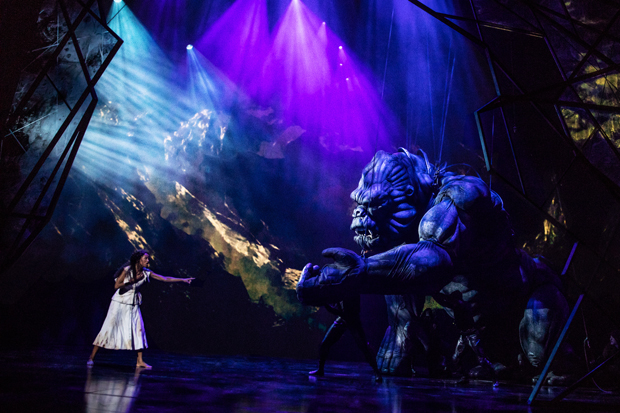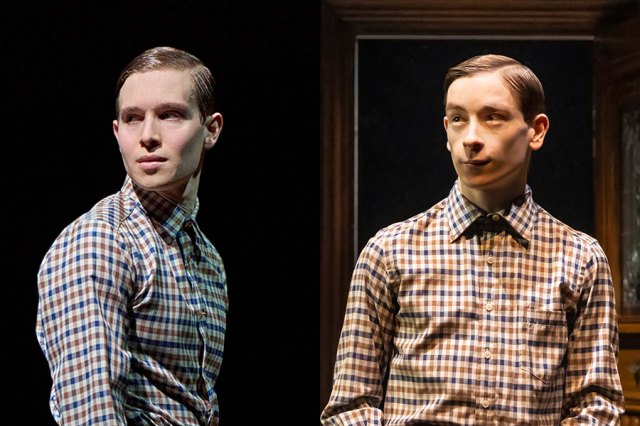Meet the Actor Who Brings Emotion to King Kong's Growls, Snarls, and Roars
Jon Hoche is the live vocal actor behind the star of Broadway’s new musical ”King Kong”.

(© Allison Stock/Joan Marcus)
Broadway's King Kong stars a two-story, two-ton gorilla puppet. Physically, the behemoth is made animate by 10 athletic puppeteers who maneuver his limbs via cables by crouching, pulling, and even rappelling off his back. But once Kong is moving, there's still one element necessary to bring him roaring to life. Enter actor Jon Hoche, voice of Kong.
Having heard about the new stage adaptation while on tour with War Horse in 2013, Hoche knew right away he wanted the gig: "I saw these YouTube videos of this incredible puppet, and I thought, 'Man oh man, when I get back to New York, that's gonna be my next job. It took a little while for them to get over here, but from day one of rehearsals in New York, I've been involved. "
As it turns out, Hoche booked not one job with King Kong, but three: In addition to voicing the puppet, Hoche is also a puppeteer remotely controlling its movements and a member of the ensemble.
According to Hoche, when the musical's creators were first developing Kong, they expected his voice to be automated. "They thought it would just be kind of, press a button for a roar, press a button for a snarl," said Hoche. "But they quickly found that he needs to be a living, breathing entity."
"It's just been a dream come true," said Hoche of the experience, "and I feel blessed that I can contribute to that by lending my voice."

(© Matthew Murphy)
Could you break down all the roles you have in King Kong?
I'm part of a trio of what we call voodoo puppeteers. We have these electronic controls for the different parts of Kong's body, but we're not connected to him. The three of us are also in the ensemble, so when Kong is not onstage, we're singing and dancing with the rest of the cast, and then when Kong arrives, I personally take care of controlling his head and neck motions. And then I have a microphone, and I also do his voice.
Do you spend the whole show running back and forth from the booth to the stage?
Not the whole show, but there are moments. I think we do clock in a good step count. I've been meaning to count how many steps we have to take and how many shows we've done, and then I want to cross-reference that to how many steps there are in the Empire State Building — to see how many times in a month we reach the top of the Empire State Building.
What past experience do you have that helped you get the King Kong gig?
I've been a huge fan of King Kong and primate performance since I was a kid. I've done puppetry before, and a lot of my work has been movement-based — fight choreography or things like that. So when it came to the audition for the voodoo puppeteer, the audition process was, get in the room and act like King Kong along with a person reading lines. And I got to show them my vocal qualities. They wanted to make sure that the voice of Kong was an actor and could emote as well as perform on the complicated rigs.
How different is this vocal performance from your typical acting experience?
Not a lot different. You still have to have intention. And you still have to know what you're saying. Someone on Twitter yesterday wrote, "I can't believe I fell in love with this giant gorilla. The only thing that would make me love him more is if he could have whispered, 'I love you.'" And I responded, "Well, I am. I'm just saying that through Kong's speech." So you have a different vocabulary, but it's all acting.

(© Matthew Murphy)
How do you coordinate Kong's voice with his movements?
There's about an eighth-of-a-second delay from what comes out of my mouth into the mic to what hits the stage. So Danny, who's on the face rig, has an eighth of a second to hear what I'm doing and then react. He and I have developed a really great friendship but also an unspoken connection. He can almost predict what I'm going to do. If someone goes up on a line or the automation is slow and we have to stall a little bit, we can work together. I can't talk to him, but we have really found this great synchronicity between the face and the voice.
How did you go about developing Kong's language and voice?
He has lines in the sense that in the script they say "roar," "grunt," "snarl." And as we were rehearsing, we would find, "Oh, that's actually more of a cough or a huff versus a snarl." So we were able to create this vocabulary for Kong.
I think he's an amalgamation of all the large creatures that I've known from King Kong movies to Ludo from Labyrinth. There could be a little bit of Sully in there from Monsters, Inc., you never know. Those are the characters that I really respond to, so it's awesome be able to be one of them now.
The biggest challenge was learning how to work with the modulation program that they've created specifically for the show. It's taking the sounds of a 6'1" man and turning them into what would come out of a 2,000-pound gorilla. They really want that all-encompassing experience for the audience aurally, to vibrate the seats, to actually scare people. So I sat in the soundproof booth trying different things with the sound designers sitting outside of the booth to see how it sounds to the audience.
Since you're in a soundproof booth, is your performance more like monologuing than working with a scene partner?
No, and that's the great thing. We're in the back of the mezzanine, so we're seeing right onto the stage. The greatest thing for me is being able to use the microphone and use the tools that I have to feel like I'm onstage with Christiani [Pitts, who plays Ann Darrow] in those scenes. I treat it just like I'm onstage acting and they're my acting partners and we're doing a show together. So sometimes someone might get a bigger roar at them because they're giving me more. It's just like any other acting job, except my instrument is a 20-foot, two-ton gorilla.

(© David Gordon)








